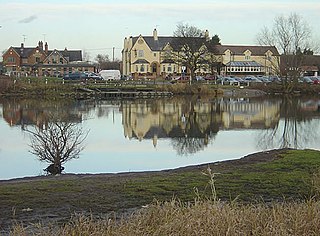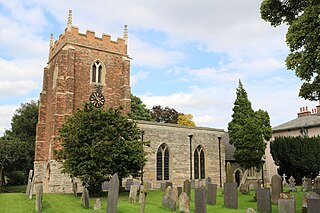
Nottinghamshire is a ceremonial county in the East Midlands of England. The county borders South Yorkshire to the north-west, Lincolnshire to the east, Leicestershire to the south, and Derbyshire to the west. The largest settlement is the city of Nottingham (323,632).

Newark and Sherwood is a local government district in Nottinghamshire, England. It is the largest district by area in the county. The council is based in Newark-on-Trent, the area's largest town. The district also includes the towns of Southwell and Ollerton along with a large rural area containing many villages. Much of the district lies within the ancient Sherwood Forest and there are also extensive forestry plantations in the area.

Southwell is a minster and market town in the district of Newark and Sherwood in Nottinghamshire, England. It is home to the grade-I listed Southwell Minster, the cathedral of the Anglican Diocese of Southwell and Nottingham. The population of the town was recorded at 7,491 in the 2021 census. The town is on the River Greet and is located geographically 9 miles (14 km) west of Newark on Trent, 15 miles (24 km) northeast of Nottingham, 13 miles (21 km) southeast of Mansfield and 22 miles (35 km) southeast of Worksop.

Colwick is a village and civil parish, in the Borough of Gedling of Nottinghamshire, England. It is situated to the east of Nottingham's city boundary, and forms the Colwick ward. At the time of the 2011 census, the village had a population of 2,829, falling to 2,778 at the 2021 census.

Thurgarton was a wapentake of the historic county of Nottinghamshire, England. It extended north-eastwards from Nottingham. The River Trent formed most of the eastern boundary. It consisted of the parishes of Averham, Bathley, Bleasby, Blidworth, Bulcote, Burton Joyce, Calverton, Carlton, Carlton-on-Trent, Caunton, Caythorpe, Colwick, Cromwell, East Stoke, Edingley, Epperstone, Farnsfield, Fiskerton, Fiskerton cum Morton, Fledborough, Gedling, Gonalston, Grassthorpe, Gunthorpe, Halam, Halloughton, Haywood Oaks, Hockerton, Holme, Hoveringham, Kelham, Kersall, Kirklington, Kneesall, Lambley, Lindhurst, Lowdham, Maplebeck, Marnham, Meering, Morton, Normanton on Trent, North Muskham, Norwell, Norwell Woodhouse, Nottingham St Mary, Ossington, Oxton, Park Leys, Rolleston, Sneinton, South Muskham, Southwell, Staythorpe, Stoke Bardolph, Sutton on Trent, Thurgarton, Upton, Weston, Winkburn and Woodborough.

Gunthorpe is a village and civil parish in Nottinghamshire, England. Its population of 752 at the 2011 census fell to 740 at the 2021 census. It lies on the left bank of the River Trent. Gunthorpe's on the A6097 is the only road bridge over the river between Newark and Nottingham.

Fiskerton is a village and former civil parish, now in the parish of Fiskerton cum Morton, in the Newark and Sherwood district, in the county of Nottinghamshire, England. It is on the west bank of the River Trent about 3 miles southeast of Southwell. The waterfront is home to million-pound residential properties, previously residences of merchants and businessmen who commuted in the 1800s to nearby Nottingham by rail from Fiskerton Station. In 1881 the parish had a population of 283.

Rolleston is a small village and civil parish in Nottinghamshire by the River Greet, a few miles from Southwell not far from the Trent and about 5 miles (8.0 km) southwest of Newark. The population of the civil parish at the 2011 census was 312, increasing to 342 at the 2021 census. It has a church dedicated to the Holy Trinity. It lies close to the railway line between Nottingham and Lincoln with a station serving the village and Southwell as well as the nearby Southwell Racecourse.

Halloughton is a hamlet and civil parish in Nottinghamshire, England, 9 miles west of Newark-on-Trent. It lies in the district of Newark and Sherwood. Most of the property there was owned by the Church Commissioners until 1952. The resident population of the parish was 65 at the 2021 census.

Morton is a village and former civil parish, now in the parish of Fiskerton cum Morton, in the Newark and Sherwood district, in the county of Nottinghamshire, England. It is located 1 mile west of Fiskerton. The parish church of St Denis was built in 1756.

Hawksworth is an English conservation village and civil parish in the Rushcliffe borough of Nottinghamshire. It lies 10 miles (16 km) south of Newark-on-Trent, adjacent to the villages of Flintham, Sibthorpe, Thoroton, Scarrington and Screveton.

The River Greet is a small river in Nottinghamshire, England. Rising close to the village of Kirklington, the Greet flows in a southeasterly direction past Southwell and Rolleston to meet the River Trent at Fiskerton.

Staythorpe is a hamlet and civil parish in the Newark and Sherwood district of Nottinghamshire, England. During the 2021 census, the population was recorded as 93 residents.

Staunton is a small village and civil parish in the Newark and Sherwood district of Nottinghamshire, England. It takes its name from the Vale of Belvoir and shares it with the local Staunton family, which has resided in the area since the Norman Conquest and possibly before, making them one of the few English families still resident on their estate.

Kersall is a hamlet and civil parish within the Newark and Sherwood district of central Nottinghamshire, England.

Skegby is a hamlet within the Marnham civil parish in Bassetlaw district, of the county of Nottinghamshire, England. It lies in the north east of the county, south east within the district and centre south of the parish. It is 122 miles (196 km) north of London, 23 mi (37 km) north east of the city of Nottingham, and 17 mi (27 km) north east of the market town of Mansfield. There are two listed buildings in the area.

Knapthorpe is a hamlet in the Newark and Sherwood district of eastern Nottinghamshire, England. It is 115 miles (185 km) north of London, 16 miles (26 km) north east of the county town and city of Nottingham, and 3+3⁄4 miles (6 km) north east of the nearest town Southwell. It is within the civil parish of Caunton.
Fiskerton cum Morton is a civil parish in the Newark and Sherwood district of Nottinghamshire, England. The parish contains eight listed buildings that are recorded in the National Heritage List for England. Of these, one is at Grade II*, the middle of the three grades, and the others are at Grade II, the lowest grade. The parish contains the villages of Fiskerton and Morton, and the surrounding area. The listed buildings consist of houses, a cottage, a church, a pigeoncote, a farmhouse and a public house.



















